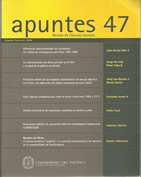Departmental differences of growth. A convergence analysis for Pery: 1961-1996
DOI:
https://doi.org/10.21678/apuntes.47.497Keywords:
Peru, economic growth, convergence hypothesis, departments, illiteracy, public investmentAbstract
Starting from the Growth Neoclassical Theory, this work explores if the benefits of growth experimented in Peru in nineties will feel in its whole population. lf that so, when it will happen? Particularly, do departments of Peru converge into a same level of per-capita product or, at least, one unique rate of growth? For no limiting this work to the starting year of departmental production statistics (1970), the GDP departmental of 1961 has been estimated also. Even though there is no evidence about convergence, it is found that it is possible for the Government to affect the long run production. In other side, analphabetism index affects negatively the value of per-capita production, that indicates importance of a educational policy in that way. Also, public investment and public expenses can attend immediate demands of ones that require it, but in the long run only affect negatively on production level.Downloads
Download data is not yet available.
Downloads
Published
2000-10-10
How to Cite
Odar Z., J. C. (2000). Departmental differences of growth. A convergence analysis for Pery: 1961-1996. Apuntes. Social Sciences Journal, (47), 5–57. https://doi.org/10.21678/apuntes.47.497
Issue
Section
Articles
License
Apuntes publishes all its articles and reviews under a Creative Commons Attribution (CC BY 4.0) license with the objective of promoting academic exchange worldwide. Therefore, articles and book reviews can be distributed, edited, amended, etc., as the author sees fit. The only condition is that the name of the author(s) and Apuntes. Revista de Ciencias Sociales (as the publisher) be cited.



.jpg)
